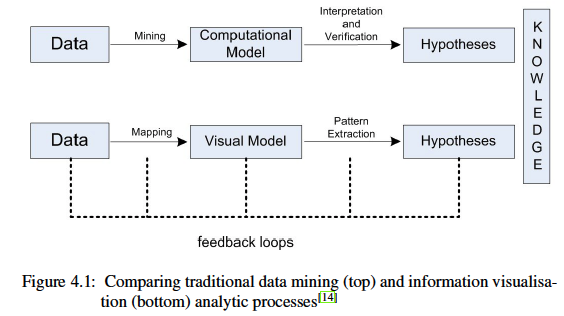Mastering the Information Age Solving Problems with Visual Analytics
Book
Keim, D. A., Kohlhammer, J., Ellis, G., & Mansmann, F. (Eds, 2010). Mastering the information age-solving problems with visual analytics. Eurographics Association.
Visual Analytics
"Visual analytics combines automated analysis techniques with interactive visualizations for an effective understanding, reasoning and decision making on the basis of very large and complex data sets"
Creating a tool and technique to enable people to:
Synthesis information and derive insights from massive, dynamic ambiguous, and often conflicting data
Detect the expected and discover the unexpected
Provide timely defensible and understandable assessments
Communicate these assessments effectively for action
Data Management
"One of the most exciting opportunities of the emerging Information Age is to extract useful findings from the immense wealth of data and information acquired, computed, and stored by modern information systems."
Obstacles:
Heterogeneity of Data Sources
Different Data Types
Data Streams
Working Under Pressure
Time Consuming Activities
Issues obstructing Data Management and Visual Analytics
Dynamicity
Standards
User Interaction Life Cycle
Data Mining
Examples of areas in which the visual analytics approach has been used together with Knowledge Discovery and Data Mining
Bioinformatics
Climate Change
Pattern Identification
Spatio-temperal Data Mining
Research and Commercial Systems in Data Mining and Visualization:
Statistical and mathematical tools (R, matlab)
Specific algorithmic tools (Graphviz or Pajek)
Visual Analytics Libraries (BirdEye)
Visual Data Mining Tools (KNIME, Weka)
Web tools and packages (MayEyes)
Scientific Visualization Tools (Globus Toolkit)
Combined Methods (JUNG, HCE)
Computational Information Design
Five categories of Grand Challenges:
Analytical Reasoning
Visual Representation and Interaction Techniques
Data Representations and Transformation
Production, Presentation and Dissemination
Moving Research into Practice
Space and Time
"Maps not only help people to orient themselves in geographical space but also to gain an understanding of events and evolving phenomena and to make discoveries – indeed, much map use can be considered (geo)visual analysis."
Specifics of Time and Space
Dependencies between observations
Uncertainty
Scale
Time
State of the Art
Representation of Space
Representation of Time
Interactive Methods of Visual Exploration
Effectiveness of Visual Techniques
Dealing with large data sets
Collaborative Visualization
Fundamental and Theoretical Research
Next Steps
Develop approaches to support analysts in finding satisfactory scales of
analysis, exploring and establishing scale dependency, verifying discovered
patterns and relationships at dierent scales and with dierent aggregations,
and understanding dependencies between phenomena operating at dierent
scales in time and space.
Develop scalable visual analytics solutions to enable integrated processing
and analysis of multiple diverse types of spatial, temporal, and spatiotemporal
data and information, including measured data, model outputs, and
action plans from diverse ocial and more uncertain community contributed
sources.
Improve the understanding of human perceptual and cognitive processes
in dealing with spatial and temporal information and visual displays of
and interaction with such information. On this basis, develop appropriate
design rules and guidelines for interactive displays of spatial and temporal
information.
Develop effective solutions for training both specialist and non-specialist
users interested in undertaking spatio-temporal analysis.
Develop a new generation of lightweight accessible dynamic visual analytics
tools to support a range of personal and professional spatio-temporal analysts
in the best possible way.
Implement tools for spatio-temporal visual analytics in the way that allows
rapid and easy deployment or online use through the Web. Make the
tools compliant with the existing and emerging standards, interoperable and
combinable; enable integration of the tools into user’s existing workflows.
Infrastructure
Perception and Cognitive Aspects
State of the Art
Psychology of Perception and Cognition
Distributed Congition
Problem Solving
Interaction
User Evaluation
Challenges
General Public need tools to understand data in their own way
Applying Psychological Theory to Real Applications
Understanding the Analytical Process
The need for design guidelines
Defining the language of visual analytics
Evaluation of Novel Designs
Designing the Analyst
Changing Interfaces: users, data and devices
Evaluation
Evaluation include techniques, methods, modes and theories as well as software tools
Quality, artefacts should be considered - the key aspects of quality are effectiveness, efficiency and user satisfaction
Users
Tasks
Artefacts
Data
Recommendations
Data - the challenge of dealing with very large, diverse, variable quality datasets
Users - the challenge of meeting the needs of the user
Design - the challenge of assisting designers of visual analytic systems
Technology - the challenge of providing the necessary infrastructure
